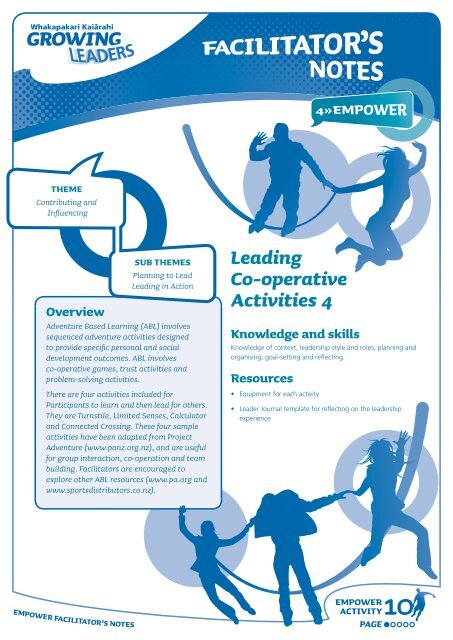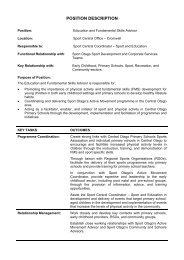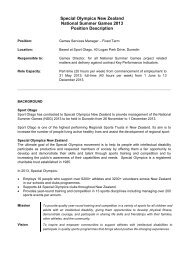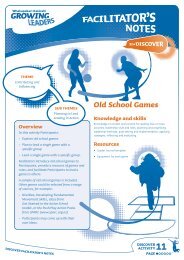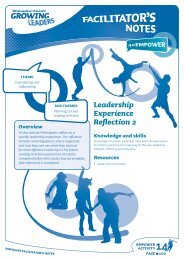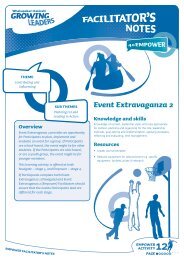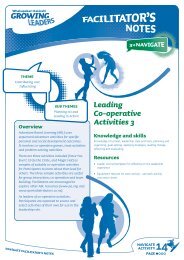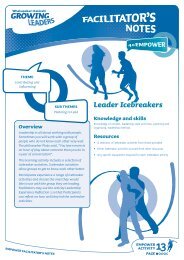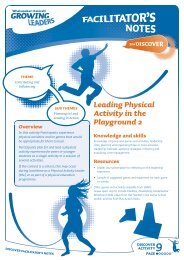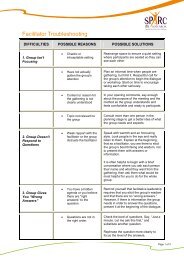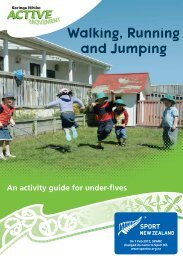Leading Co-operative Activities 4 - Sport New Zealand
Leading Co-operative Activities 4 - Sport New Zealand
Leading Co-operative Activities 4 - Sport New Zealand
Create successful ePaper yourself
Turn your PDF publications into a flip-book with our unique Google optimized e-Paper software.
vv vvavv<br />
THEME<br />
<strong>Co</strong>ntributing and<br />
Infl uencing<br />
SUB THEMES<br />
Planning to Lead<br />
<strong>Leading</strong> in Action<br />
Overview<br />
Adventure Based Learning (ABL) involves<br />
sequenced adventure activities designed<br />
to provide specifi c personal and social<br />
development outcomes. ABL involves<br />
co-<strong>operative</strong> games, trust activities and<br />
problem-solving activities.<br />
There are four activities included for<br />
Participants to learn and then lead for others.<br />
They are Turnstile, Limited Senses, Calculator<br />
and <strong>Co</strong>nnected Crossing. These four sample<br />
activities have been adapted from Project<br />
Adventure (www.panz.org.nz), and are useful<br />
for group interaction, co-operation and team<br />
building. Facilitators are encouraged to<br />
explore other ABL resources (www.pa.org and<br />
www.sportsdistributors.co.nz).<br />
<strong>Leading</strong><br />
<strong>Co</strong>-<strong>operative</strong><br />
<strong>Activities</strong> 4<br />
Knowledge and skills<br />
Knowledge of context, leadership style and roles, planning and<br />
organising, goal-setting and reflecting.<br />
Resources<br />
• Equipment for each activity<br />
• Leader Journal template for reflecting on the leadership<br />
experience<br />
EMPOWER FACILITATOR’S NOTES<br />
EMPOWER10<br />
ACTIVITY<br />
PAGE
vv vvavv<br />
STEP 1<br />
Ensure that the right equipment is available for each of the<br />
activities in the session. If possible, set up all of the activities<br />
before the session.<br />
STEP 2<br />
Begin with Turnstile for approximately 15 minutes, followed<br />
by Limited Senses (15 minutes), Calculator (25 minutes) and<br />
<strong>Co</strong>nnected Crossing (15 minutes). Allow enough time for note<br />
taking after each activity.<br />
STEP 3<br />
Facilitate each activity by:<br />
1. Briefing Participants on the activity<br />
2. Observing the Participants during the activity<br />
3. Facilitating a debrief at the end of each activity.<br />
Sample debrief questions<br />
Turnstile<br />
In what ways did the team work together?<br />
How did setting a goal help with the success of the activity?<br />
Limited Senses<br />
What was it like having some of your senses removed?<br />
What did you learn about the importance of these senses?<br />
Calculator<br />
Describe what helped the group to improve their time?<br />
How did you decide on which strategies to try?<br />
<strong>Co</strong>nnected Crossing<br />
What needed to happen in order to achieve the goal?<br />
Were there any barriers that stopped or limited the group from<br />
achieving the goal?<br />
How could you do better next time?<br />
STEP 4<br />
Each Participant leads a small group, e.g. six children, in a<br />
co-<strong>operative</strong> activity or session of activities. A session could be<br />
approximately 70 minutes and include four games.<br />
STEP 5<br />
The Participant writes a response to each activity in their<br />
Leader Journal template. The Facilitator may use the Growing<br />
Leaders Criteria Checklist (in the “Facilitator Guide”) or the<br />
learning activity Leadership Experience Reflection 2 to provide<br />
Participants with feedback on their leadership.<br />
TURNSTILE<br />
OBJECTS USED<br />
One long rope.<br />
SET-UP<br />
Two people turning a long rope between them,<br />
as in skipping.<br />
DESCRIPTION<br />
Participants must run from one side of the rope<br />
to the other without jumping. One person<br />
(and only one person) must run though every<br />
time the rope is turned. As a team, a goal must<br />
be set to decide how many people can run<br />
through, one at a time, without a turn of the<br />
rope being missed. The team then attempts to<br />
achieve this goal, trying a number of times, and<br />
increasing the goal if they reach their target.<br />
ALTERNATIVES<br />
The rope turners can be included in the team,<br />
with strategies needing to be developed to<br />
get those people through the rope as well.<br />
This may involve swapping the rope with a<br />
team member while turning. A jump could be<br />
added – for example run in and jump once and<br />
then run out. The team could be allowed to<br />
run through more than one at a time, with the<br />
target being the fewest turns for the whole<br />
team to make it through. This could be with or<br />
without a jump. The group itself can also be<br />
asked to invent new challenges.<br />
10 EMPOWER<br />
ACTIVITY<br />
NOTES<br />
PAGE EMPOWER FACILITATOR’S
vv vvavv<br />
vv vvavv<br />
OBJECTS USED<br />
One blindfold per person.<br />
SET-UP<br />
LIMITED SENSES<br />
Participants in a circle, wearing blindfolds or with their eyes shut.<br />
DESCRIPTION<br />
Give each participant a different number, ensuring that participants<br />
can’t tell who has been given which number. They can then put<br />
their blindfolds on. Without talking, the team must now line up in<br />
numerical order. Be careful to maintain safety – such as hands out<br />
in front (bumpers up), slow walking and reassure them that you are<br />
watching to stop collisions.<br />
ALTERNATIVES<br />
To add difficulty, you can give numbers that are not consecutive for<br />
example 1, 2, 3, 6, 8, 13, 14 etc. Always ensure you have a 1, and a<br />
number that represents how many there are in the group. You can<br />
time the activity then give time to strategise before trying again.<br />
OBJECTS USED<br />
Numbered spot markers from 1-30, boundary cones or ropes.<br />
An alternative is to draw on concrete with chalk.<br />
SET UP<br />
Using either a rope or cones, mark out a circle. Randomly place the<br />
numbered spot markers inside the circle.<br />
DESCRIPTION<br />
CALCULATOR<br />
The team starts behind the line of cones. It is their task as a team<br />
to stand on those numbers in numerical order as quickly as possible.<br />
(They do not all have to stand on every number – once one person<br />
stands on ‘1’, the team is then going for ‘2’.) Only one person is<br />
allowed in the circle at any time. Any time there are two people in<br />
the circle at the same time, a 5 second penalty is added. They are<br />
told that they only have ‘X’ number of attempts to get their fastest<br />
time (often four or five attempts). Time starts when the first person<br />
in the team crosses the line of cones, and it ends when the last<br />
person crosses back over the line after the last number has been<br />
stepped on.<br />
ALTERNATIVES<br />
Remove some of the dots so that the numbers are not consecutive.<br />
Still require numerical order (for example 1, 2, 5, 6, 8, 10). Don’t<br />
limit the number of attempts, but set a time limit on the task. They<br />
can have as many attempts as they can fit in that time. Design a<br />
theme or story around the task – for example the numbers may be<br />
a part of a mainframe computer keyboard that has malfunctioned<br />
and the code must be entered to stop the computer causing<br />
a meltdown.<br />
EMPOWER FACILITATOR’S NOTES<br />
EMPOWER10<br />
ACTIVITY<br />
PAGE
vv vvavv<br />
vv vvavv<br />
OBJECTS USED<br />
ALTERNATIVES<br />
CONNECTED CROSSING<br />
<strong>Co</strong>nes, ropes or court markings to form 2 lines.<br />
SET-UP<br />
Two parallel lines, up to 5 metres apart. The<br />
participants stand on or behind one line while<br />
facing the other.<br />
DESCRIPTION<br />
Participants stand on the first line, and are<br />
told that they must reach the second line as a<br />
team. They must travel over the end line while<br />
maintaining continuous contact with their feet.<br />
If anyone in the group loses contact with their<br />
partner’s foot, the entire group must start over.<br />
Even if some of the members cross the line,<br />
they must stay completely connected until their<br />
whole team is across the line.<br />
This activity can be attempted silently. A<br />
scenario can be given so that there is a story<br />
leading into the activity. The group can be split<br />
in two and the groups race each other – this<br />
adds more pressure and generally causes more<br />
mistakes – a great adaptation for a debrief<br />
focused on pressure.<br />
10 EMPOWER<br />
ACTIVITY<br />
NOTES<br />
PAGE EMPOWER FACILITATOR’S
vv vvavv<br />
vv vvavv<br />
vv vvavv<br />
vv vvavv<br />
vv vvavv<br />
vv vvavv<br />
NAME<br />
<strong>Leading</strong> <strong>Co</strong>-<strong>operative</strong><br />
<strong>Activities</strong> 4<br />
Reflecting on your leadership<br />
When you led this co-<strong>operative</strong> activity:<br />
Name of co-<strong>operative</strong> activity I led is...<br />
1. What went well?<br />
5. What did you learn about<br />
your leadership?<br />
2. Why did it go well?<br />
6. What would you change about your<br />
leadership next time you are in a<br />
leadership position?<br />
3. What would you change next time?<br />
4. What surprised you?<br />
EMPOWER LEADER JOURNAL<br />
EMPOWER10<br />
ACTIVITY<br />
PAGE


